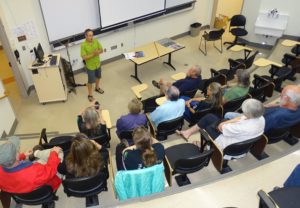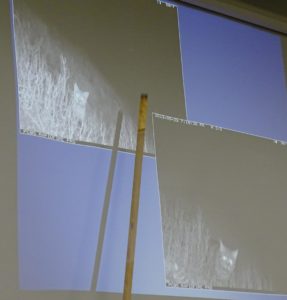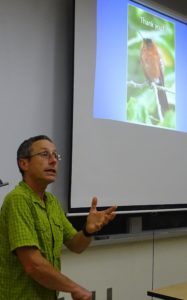If anyone left a gray-and-white striped Nautica jacket, contact us!
Dr. Peter Hodum of UPS made a return appearance to ABC on September 12, 2017, this time to talk about his work on the Juan Fernandez Islands way off the coast of Chile, which he’s talked about before, besides his presentations on Alcids off the coast of Washington and plastic in our seas. His enthusiasm for these small remote islands could barely be contained, as over the years he’s become acquainted with the population and become part of their family.
Peter started by showing the map of the islands and then debunked the rumor that Alexander Selkirk, who was in fact left for some time on the island now known as Robinson Crusoe Island, although never set foot on the island now known as Selkirk Island, was actually the model for Defoe’s Robinson Crusoe (totally wrong island for the flora, fauna, and geography described in the book). The real history is fascinating in that there were no humans “native” to these islands historically.
As you would expect for such remote islands, the percentage of endemics is very high, although the fight to eradicate the mammals and plants brought by people is constant now, including cats (of course), rabbits, rats, and blackberries! The smallest of the three main islands, Isla Santa Clara, has successfully eradicated rabbits, and the burrow-nesting Pink-footed Shearwaters have bounced back amazingly since then. This bird we often see on pelagic trips off our own coast is actually an endemic nester in the Juan Fernandez Islands! The story of how the rabbits were eradicated is almost funny, as they did it the long way and the hard way rather than the quick and easier way that’s been perfected elsewhere, but they did accomplish it! The two larger islands still have to deal with rabbits, rats, and cats, all of which are being tackled in various ways.
Peter says he just loves tubenoses! The six seabird species who nest in these islands are all tubenoses, and four are endemic. One of the other endemics that he talked about was de Filippi’s Petrel, a charming looking bird about which virtually nothing was known before Peter’s group started studying them. There were zero studies and zero facts, but that’s changed, of course, and it’s now acknowledged to be highly endangered. Peter has made friends with fishermen, and they’ve become some of his best colleagues in gathering info on seabirds as well as suggesting methods to lower bycatch. One of these friends did a complete survey of one of the northern rocks known as the des Venturadas Islands, way more than the requested survey! One way Peter’s group has “enlisted” fishermen is by giving them instruction in identifying seabirds, including informative calendars.
Yes, there are passerines, too. The critically endangered Másafuera Rayadito has now been adopted as a school mascot and embraced by the people since they found out from Peter’s group that it’s endemic and very special and needs their help. They had no idea about any of this before this educational input.
And the hummer! The stunning Juan Fernandez Firecrown is found only on Robinson Crusoe Island and has been declining rapidly. The more widespread and continental Green-backed Firecrown has started to crowd it out as the countryside has become more degraded, and severe storms the past two seasons have devastated them. The hope is that it really was the storms and that they’ll bounce back after a couple of seasons of more normal weather.
The amazing native flora of these islands is almost all endemic, including all tree species, but it is rapidly being degraded by exotics. Clearings in these areas have brought back endemic birds rapidly, but it’s hard and constant work.
Peter has forged relationships in these islands, and that has been both personally rewarding to all, but also has advanced the science in ways that might not have been possible otherwise. That’s a great take-away, Peter!
For more info on Peter Hodum’s group, Oikonos, go to: http://oikonos.org/about/









Great report Diane. Kay and I are jealous that we missed the meeting.
Great report Diane. Kay and I are jealous that we missed the meeting.